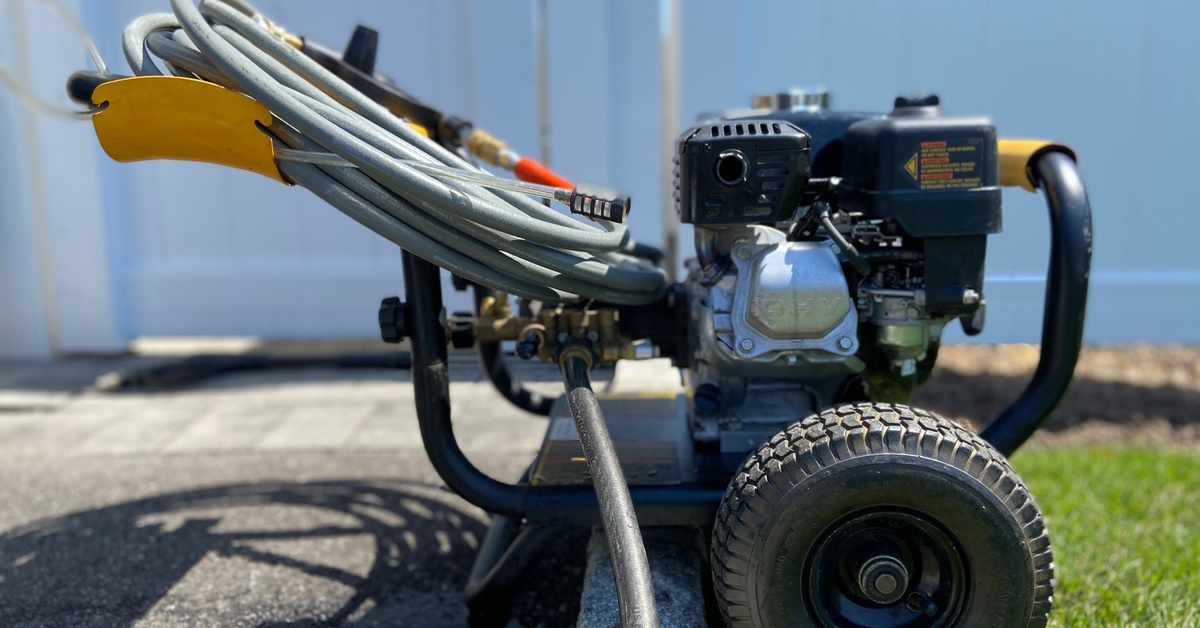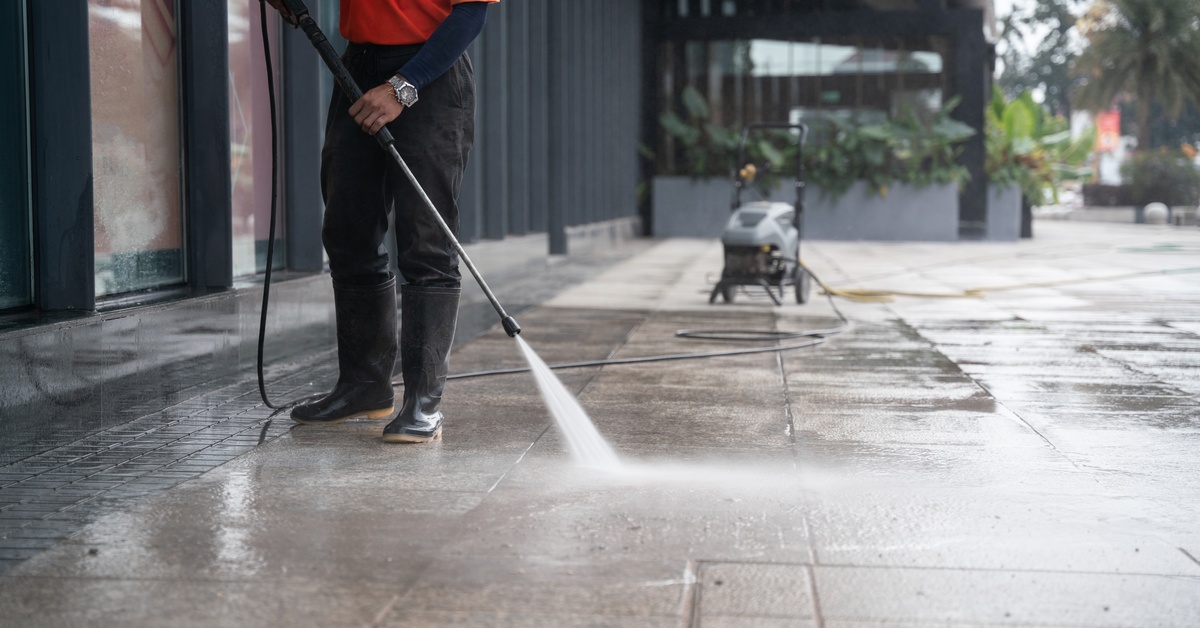
Author: Tyler Mashek
Pressure washers are a highly effective tool for cleaning stubborn grime, dirt, and stains from surfaces, such as driveways, patios, and house exteriors. They save time and effort while delivering superior results compared to traditional cleaning methods.
However, to ensure they function properly and last for many years, you must understand how to use them correctly. One common mistake even professional pressure washing companies make is attempting to use an incompatible hose with their pressure washer. Keep reading to learn why you should never use the wrong hose on a pressure washer.
Professional pressure washing companies should know that not all hoses are compatible with their high-pressure equipment. Standard garden hoses, as their name suggests, best suit general watering tasks, such as hydrating plants or washing cars. Due to their lightweight materials and basic design, these hoses lack the durability required to handle high-pressure water output.
Pressure washers can often generate thousands of pounds per square inch (PSI) of pressure through their hoses - significantly higher in comparison to the standard water flow from a garden hose tap.
Another example of using the wrong hose is when working with high temperature pressure line. Even when using a high-pressure jetting hose, using standard hoses instead of those formulated for high temperatures can result in the hose’s coating melting under the high heat.

Using a standard hose with a pressure washer might seem like a convenient solution, but it can lead to serious issues. This section will take a deeper look at the potential risks and damages associated with this practice to help you understand why using the correct equipment is key.
Pressure washers work with certain hose sizes and types. An incompatible hose cannot handle the flow or pressure output from these machines and will break both themselves and possibly damage your pressure washer.
You can also encounter safety risks when using the wrong hose on a pressure washer. Pressure washers emit incredibly powerful jets of water, and if the hose isn’t compatible with this force, it could rupture.
A ruptured hose could spray high-pressure water uncontrollably, posing a hazard to the user and anyone nearby. Additionally, sudden bursts of water could lead to accidental property damage, such as broken windows or dented surfaces.
Pressure washers operate with water pressure measured in PSI (pounds per square inch), significantly higher than the typical pressure some hoses can handle. A pressure washer will output somewhere between hundreds and sometimes over 4000 PSI, depending on the model and the task.
Selecting the correct hose starts with making sure it is strong enough to withstand the maximum output of your pressure washer. Be sure to check your pressure washer’s operator’s manual or look for the specification stamped somewhere on the pressure pump. Once you have a hose that can handle the max output, you’ll want to take note of the task at hand:
<1,000 PSI: Ideal for light-duty tasks such as washing windows or cleaning outdoor furniture and vehicles. Some consumer-rated rubber hoses and pressure washing systems will be suitable for these types of applications.
1,500-2,000 PSI: Best for medium-duty cleaning, such as washing decks, patios, or vinyl siding. Use a hose specifically rated for medium pressure to ensure consistent water flow and avoid damage.
3,000 PSI: Perfect for heavy-duty tasks like removing tough stains, cleaning driveways, or stripping paint. A reinforced, high-pressure hose is required to handle this level of power without leaks or bursts.
4,000 PSI: Designed for professional-grade cleaning, such as removing grease, graffiti, or heavy grime from concrete and industrial surfaces. At this pressure, a high-strength, steel-braided hose is essential to withstand the force.
5,000 PSI and above: Reserved for extreme cleaning jobs, including industrial equipment or large-scale construction projects. Only use ultra-durable, professional-grade hoses capable of handling this immense pressure.
Additionally, high-temperature pressure washing systems will require hoses with high-temperature safe coatings, as standard coatings can melt under high temperatures. Selecting the right PSI level and corresponding hose will help improve cleaning efficiency and protect your equipment for safe usage.

Choosing the right hose for your pressure washer is essential to avoid these risks and achieve the best cleaning results. Pressure washer hoses are specifically engineered to handle high pressure and maintain reliable performance over time.
Synthetic rubber hoses are among the most reliable options for pressure washers. Known for their flexibility and durability, these hoses can handle high levels of water pressure and resist kinks or tangles.
They often feature wire braids or other materials, which provide extra support under high-stress conditions. Synthetic rubber hoses are typically a premium choice for professional users or those frequently using their pressure washers.
Specialty hose coatings provide additional functionality and protection to pressure washer hoses, catering to specific jobsite needs and challenging environments. For example, non-marking hose coatings prevent scuff marks or stains on job sites with finished surfaces, such as driveways, floors, or tiled areas. These coatings ensure that the hose glides smoothly without leaving unsightly marks behind.
Additionally, specialty jetting hoses have coatings that allow them to slide easily through pipes for cleaning. Compare this to standard pressure washing hoses which specialize in surface cleaning.
When selecting a pressure washer hose, start by checking your manufacturer’s specifications. Always use a hose with the correct diameter and pressure rating for your pressure washer model.
Look for hoses with strong fittings to ensure a secure connection and consider the length of the hose based on your pressure-washing tasks. A longer hose will give you more range, while a shorter one may offer more consistent pressure.
Invest in hoses made from high-quality materials such as synthetic rubber or polyurethane for longevity and reliability. Avoid compromising with low-grade hoses, as they may cost you more in repairs or replacement costs down the line.
When searching for quality pressure washer hoses, turn to trusted suppliers like Varco Supply. Known for offering a wide range of high-grade pressure washer accessories, Varco Supply provides durable hoses that can handle high-pressure operations effectively. Our pressure washer supplies meet the needs of both residential and professional users, ensuring you find the right solution for your equipment.
Using the correct hose on your pressure washer is essential if you value efficiency, safety, and the longevity of your equipment. Remember to never use the wrong hose for pressure washing, as it will only result in a mess of a broken hose, water, and possibly a damaged pressure washer. On the other hand, investing in a proper pressure washer hose ensures reliable water flow, better cleaning results, and long-term durability.
To maximize the value of your pressure washer and achieve excellent cleaning outcomes, browse our selection of power washing hoses at Varco Supply. Find hoses, nozzles, and everything you need to properly equip your machine. Avoid unnecessary risks and costly mistakes by choosing the right tools for the task.